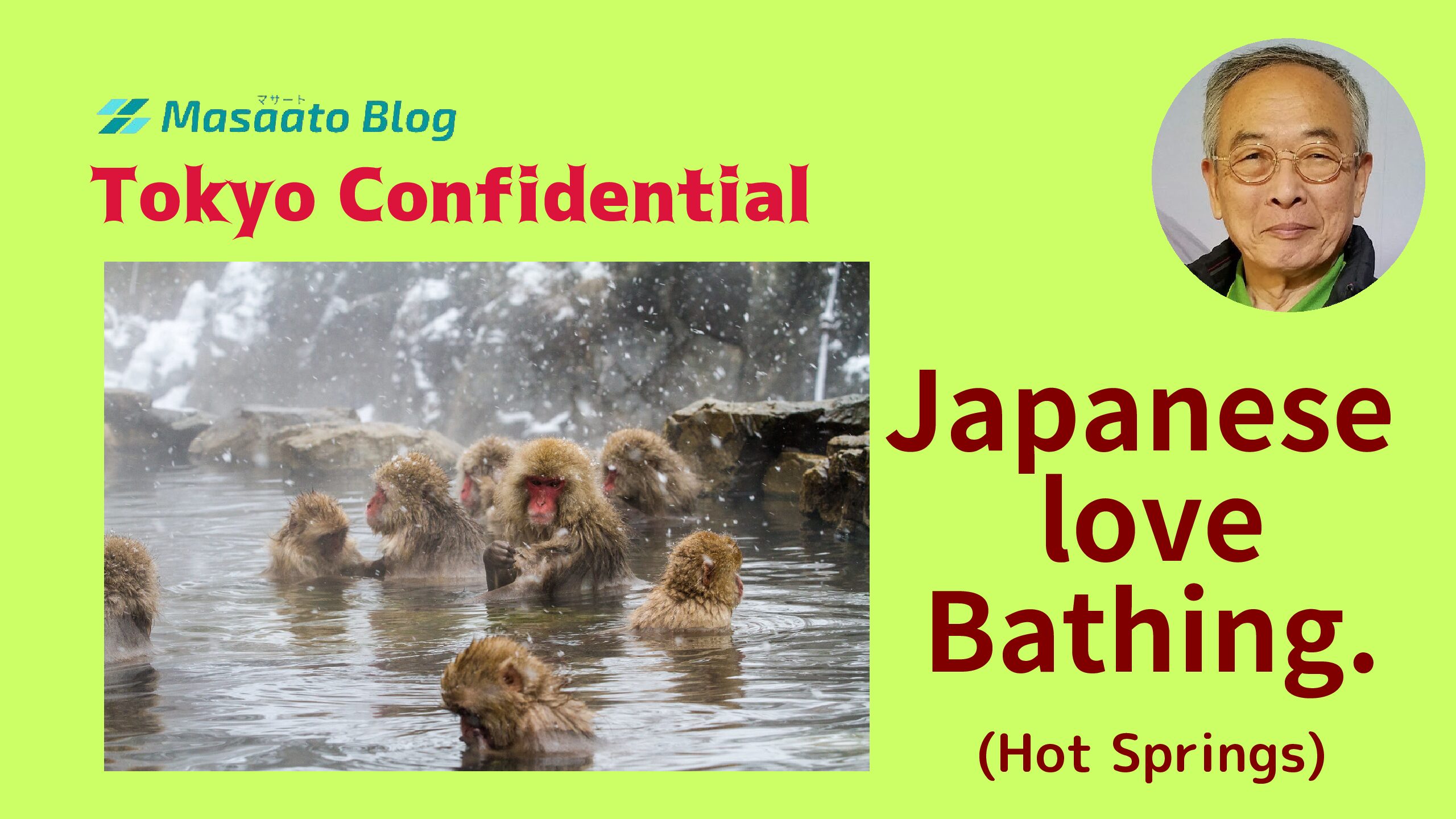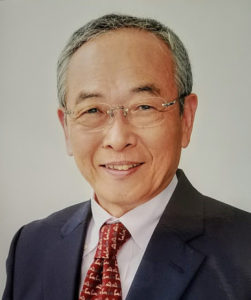本稿の日本語訳はこちら⇒https://masaato.com/furo-onsen-j/
【contents】
Japanese people take a bath almost every day.
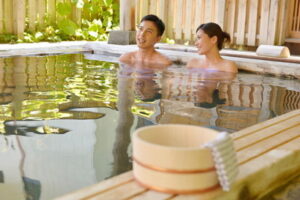 Most Japanese take a bath every day. After work, before dinner, or in winter, before going to bed, we Japanese take a bath. When the body is warm, we can sleep well. Bathing relieves the fatigue of the day.
Most Japanese take a bath every day. After work, before dinner, or in winter, before going to bed, we Japanese take a bath. When the body is warm, we can sleep well. Bathing relieves the fatigue of the day.
Japan has four distinct seasons: spring, summer, fall, and winter. Spring and summer are generally warm and humid, and the body sweats during the day. If we do not cleanse and refresh ourselves of this sweat, we will not feel like eating dinner or going to bed. Since ancient times, we Japanese have always favored cleanliness above all else.
In spring and summer, when we wake up in the morning, our bodies may be sweaty, so we take a shower to cleanse ourselves and refresh ourselves.
In fall and winter, there is not much chance of sweating during the day. Even so, we Japanese people bathe every day to keep our bodies clean. We like to enjoy the feeling of relaxation during and after bathing. We soak in the bathtub and warm ourselves until our foreheads break out in a sweat.
Throughout the year, it is very pleasant to be exposed to the natural breeze or the cool breeze of the air conditioner after taking a bath.
Bathing at night is probably because of the Shinto concept of Misogi. The idea of washing away the day’s sins before the day is over. It is thought to be rooted in this Shinto idea.
If we clean ourselves up, we feel secure. If we don’t keep it clean, we feel uneasy, and we feel that the evil spirits that love filth will be attracted to us and that nothing will go wrong. Such Shinto psychology is present in us Japanese.
There are two types of baths in Japan: home baths and public bathhouses. Public bathhouses include Sento and Super Sento.
Sento were basically facilities used by people who did not have a bath at home.
Once a place of relaxation for bath-loving Japanese, Sentos are becoming fewer and fewer every year. 3900 Sentos nationwide as of the end of March 2017, falling below 4000 for the first time since statistics began. The household bath penetration rate reached 95.1% in 2008, up from 59.1% in 1963. The fee for using the Sento is about 500 yen per adult.
By 2013, almost all households hold home-use baths. In other words, the household is now sufficient for washing the body and keeping it clean.
There are currently about 20,000 Super Sento other than Sento throughout Japan. There, visitors can enjoy a combination of various types of baths, such as utaseyu(a stream of hot water falling down on your shoulders like a small waterfall), Jacuzzi, mist saunas, and Chinese herbal medicine baths. They have become a popular and easy leisure activity.
The fee for an adult is approximately 1,000 yen. Some Super Sentos charge more, depending on the quality of the facilities.
History of Bathing in Japan
It is said that bathing in Japan began with misogi or purification. It is a Japanese Shinto practice of ritual purification by washing the entire body of sins, which was performed in rivers and waterfalls. The purpose of misogi is to purify the body and spirit with water or hot water, which is different from today’s bathing experience where we relax in hot water.
There are more than 100 active volcanoes in Japan. As a result, there are now about 3,000 hot spring resorts throughout the country. Therefore, apart from religious ablutions, there has always been another way to use hot springs: to relax by soaking in the hot water. There are historical remains that indicate that we used them as early as the Jomon Period (8,000-3,000 BC).
The earliest documented mention of hot springs is found in Japan’s oldest history book, Kojiki (Record of Ancient Matters), compiled in 712, and in the Chronicles of Japan, Nihon Shoki, completed in 720.
Based on these documents, Dogo Onsen (Ehime Prefecture), Arima Onsen (Hyogo Prefecture), and Shirahama Onsen (Wakayama Prefecture) are known as the “three oldest hot springs in Japan.”
In the Nara period (710-794), Buddhist temples such as Todaiji Temple (Nara Prefecture) and others held a similar religious practice called Seyoku, in which they opened their bathrooms to the poor, the sick, and prisoners to bathe. These were not baths in a bathtub as we know it today, but steam baths in which steam was used to wash away dirt and grime from the body.
In ancient and medieval times, when sanitary facilities were not available, temples also served as hospitals, and bathing was an important missionary activity.
Benefits of Bathing
Bathing by submerging the body in a bathtub has many positive effects, such as the following. These effects cannot be expected from taking a shower.
- Waste matter and perspiration are released from the body.
- The effect of the pressure of the hot water promotes blood circulation and metabolism.
- Cancer cells are vulnerable to heat, so it helps prevent cancer.
- There is a massaging effect due to the temperature and pressure of the hot water.
- The body becomes clean and refreshed.
- Relax your body and mind comfortably and relieve stress.
- Sleep well and recover from fatigue
How to take a home-use bath
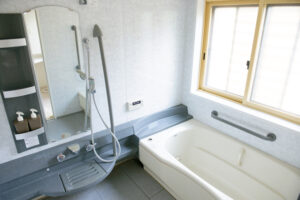 A standard Japanese home bathroom includes a bathtub, shower, and washing area.
A standard Japanese home bathroom includes a bathtub, shower, and washing area.
The order of use is as follows;
(1) Remove all clothing in the changing room.
(2) After entering the washing area, sit down and take a shower to rinse your head and entire body to remove sweat and other noticeable dirt. If there is a small chair, sit on it. If there is a washbasin, fill it with hot water from the hot water faucet, soak a towel in it, and wash yourself. Soak the towel in the washbowl and wring it out tightly.
(3) Soak naked in the bathtub. When getting into the bathtub, do not put towels or anything else into the hot water. Do not put anything into the bathtub except your body.
(4) After getting warm, go out to the washing area and wash your head and body with shampoo and soap. Containers for shampoo, body soap, and rinse are labeled in English. Always wash outside the bathtub, sitting on a chair.
(5) Shower to rinse off any soapy bubbles on the body.
(6) Soak in the bathtub. Do not put towels or other items in the bathtub.
(7) When you get out of the bathtub, take a shower over your entire body and wipe yourself with a towel.
(8) Do not drain the hot water from the bathtub, cover it with a lid, and exit the bathroom.
- Caution;
Some people omit 3). This tendency is strong among those who have the disposition of Edo spirit, who do not consider it a good thing to cause trouble to others.
Anyway, do not drain the hot water out. The whole family use the same bath of hot water that night. At the end of your bathing, you take a shower.
Sento (public bathhouse)
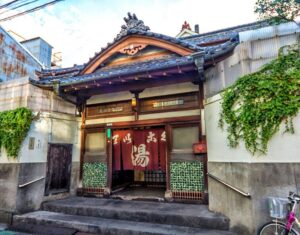
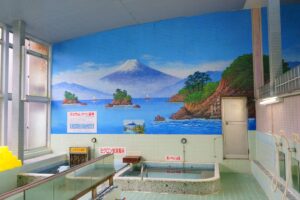
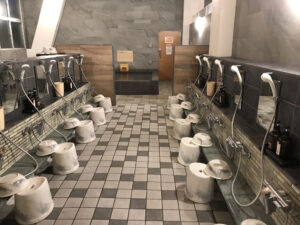
Today, most Japanese households have baths, but many people prefer Sento (public bathhouses) to home baths. This is because they are spacious and comfortable. When I was an office worker, I often took my son to the Sento on weekends.
The fee is 500 yen per adult (in 2023).
As a tourist guide, I often took foreign tourists visiting Japan to ordinary Sento in the city. It was the first time for them to bathe naked with ordinary Japanese people, but they were very pleased with the experience, saying “We are reborn!”
Super Sento
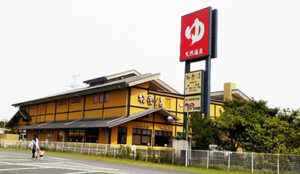
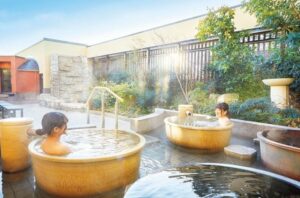
In most cases, a Sento has only a big bathtub, a washing and shower area, and a changing room.
A Super Sento, on the other hand, has been established for the first time in Japan in 1985. In addition to regular bath facilities, these facilities offer saunas, Jacuzzis, water baths, open-air baths, electric baths, utaseyu(a stream of hot water falling down on your shoulders like a small waterfall), and other bathing facilities. There is also a restaurant and barbershop attached to the building.
In other words, a Sento is a bathhouse that specializes in bathing, while a Super Sento is a bathhouse that offers a full range of bathing facilities. Usually, the water is boiled, but some of them are blessed with locations where you can soak in real hot spring water.
The fee depends on the abundance of facilities but is usually 1,000 yen per adult.
How to Use Sento When Touring Japan
At these unique Japanese Sento and Super Sento, you can casually talk with Japanese people nearby, and we recommend that you experience them to understand Japanese culture when you visit Japan. However, it is unfortunate that only about 5% of Japanese can speak English. But, please don’t worry about that and try to talk to them actively. I am sure you will have a pleasant communication experience.
As for what you can and cannot do in the bathhouse, look carefully at what the Japanese people around you do.
Japanese people also like Onsen(hot springs).
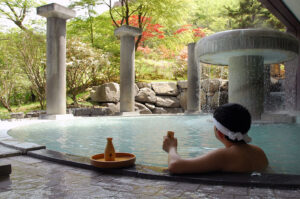
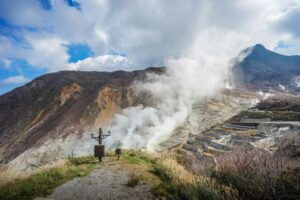
Because Japan is a volcanic country, bathing facilities such as Onsen Ryokan (Japanese-style inns with a hot spring)and Sentos (public bathhouses) abound. In addition to the physical benefits of these facilities, such as cleansing the skin, warming the body, and relieving fatigue, they also have mood-enhancing effects that relax the body and mind.
An Onsen(hot spring) is usually only available to visitors who stay at Ryokan (Japanese-style inns) or hotels in hot spring resorts. Recently, however, it has become possible to enjoy a “one-day spa” where you can use the onsen and have a meal without staying at a ryokan or hotel.
In addition, local governments in hot spring resort areas operate public baths like Sentos, which are much cheaper than the “one-day onsen” at Ryokans and hotels.
There are also Toji systems (hot spring cures) or onsen treatments for nerve pain, respiratory problems, and post-accident healing after traffic accidents. In this treatment, a person stays at a ryokan in a hot spring resort for a week, 10 days, or even a month in the case of a long stay, at a low rate. Meals are prepared by the residents themselves. Cooking facilities and utensils are provided.
Some general apartments in hot spring resorts have their own public bath space with hot spring water in addition to their own bathrooms. Residents of the apartments can use these public bath spaces free of charge 24 hours a day, 7 days a week.
As mentioned above, Japan is located on the Pacific Rim of Volcanoes, so you can enjoy hot springs all over the country. I hope you will enjoy the hot springs when you visit Japan.

